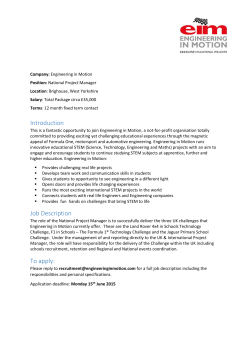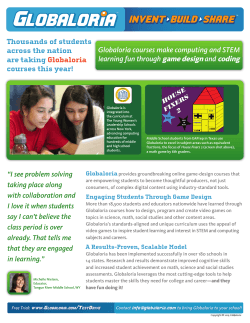
34-2014 Li Phomopsis Inoculation Final Report
MISSISSIPPI SOYBEAN PROMOTION BOARD PROJECT NO. 34-2014 (YEAR 2) 2014 FINAL REPORT Title of project: Development of a seedling inoculation technique to evaluate soybean for resistance to Phomopsis seed decay: proof of concept Principal investigator: Shuxian Li, Research Plant Pathologist, USDA-ARS, Crop Genetics Research Unit (CGRU), Stoneville, MS 38776. Phone: 662-686-3061. Email: shuxian.li@ars.usda.gov. EXECUTIVE SUMMARY Phomopsis seed decay (PSD) can severely affect soybean seed quality due to reduction in seed viability and oil content, alteration of seed composition, and increased frequencies of moldy and/or split beans. PSD has resulted in significant economic losses in the southern United States. Finding new sources of resistance to PSD requires reliable disease evaluation techniques. Development of a fast inoculation and seedling assay under controlled conditions will facilitate identification of genotypes with resistance to PSD without waiting the whole growing season and without the concern of the environment effects. The objectives of this research are to: (1) develop a seedling inoculation technique under controlled conditions to evaluate soybean for resistance to Phomopsis seed decay; (2) apply the seedling inoculation technique to test selected soybean varieties from our previous field trails at Stoneville (MSPB funded project #30-2013); (3) analyze the correlation between seed assays from whole-season field trails and the seedling assays; and (4) provide information about soybean varieties with Phomopsis seed decay (PSD) resistance and high seed quality that are identified by both seed and cut-stem assays to members of the soybean industry. The correlations between seedling and field assay data are very encouraging. The seedling cut-stem inoculation method is easy and fast, and will facilitate identification of genotypes with resistance to PSD without waiting the whole growing season, and without the concern of possible environment effects that occur in the field that may or may not result in PSD infection in a natural setting. BACKGROUND AND OBJECTIVES Phomopsis seed decay (PSD) can severely affect soybean seed quality due to reduction in seed viability and oil content, alteration of seed composition, and increased frequencies of moldy and/or split beans. Hot and humid environmental conditions, especially during the period from pod fill through harvest stages, favor pathogen growth and disease development. PSD has resulted in significant economic losses. In 2009, due to the prevalence of hot and humid environmental conditions during the pod fill to harvest WWW.MSSOY.ORG June 2015 1 period in the southern United States, PSD caused over 12 million bushels of yield loss in 16 states, including 2.2 million bushels of yield loss in Mississippi. There are few management strategies for this disease, and these strategies have not completely protected soybean against PSD. Resistant varieties can provide some protection at no additional cost to the grower above the price of the planting seed. Soybean varieties may vary for resistance or tolerance to PSD. The disease development is very sensitive to environment, and the severity varies by years and location. Finding new sources of resistance to PSD requires reliable disease evaluation techniques. Development of a fast inoculation and seedling assay under controlled conditions will facilitate identification of genotypes with resistance to PSD without waiting the whole growing season and without the concern of the environment effects. PSD is primarily caused by Phomopsis longicola. This fungal pathogen has been reported to infect all parts of soybean tissues. Therefore, we hypothesize that results from inoculation of soybean seedlings under controlled conditions and the measurement of stem lesion after inoculation would be comparable to the seed assay from the whole season of the field tests. We propose to develop a fast seedling inoculation technique at seedling (V2-V4) stage in a growth chamber to evaluate soybean for resistance to Phomopsis seed decay. The seedling cut-stem inoculation approach was used to compare the aggressiveness of P. longicolla isolates from different geographic origins (Li, et al., 2010). The objectives of this research are to: (1) develop a seedling inoculation technique under controlled conditions to evaluate soybean for resistance to Phomopsis seed decay; (2) apply the seedling inoculation technique to test selected soybean varieties from our previous field trails at Stoneville (MSPB funded project #30-2013); (3) analyze the correlation between seed assays from whole-season field trails and the seedling assays; and (4) provide information about soybean varieties with Phomopsis seed decay (PSD) resistance and high seed quality that are identified by both seed and cut-stem assays to soybean growers and the seed industry persons interested in disease resistance and seed quality. REPORT OF PROGRESS/ACTIVITY To develop a seedling inoculation technique under controlled conditions to evaluate soybean for resistance to Phomopsis seed decay (PSD), a pilot study was conducted to test a well-documented PSD-susceptible cultivar Williams 82. We analyzed the effect of plant ages (2, 3, 4, and 5 weeks old) on the stem lesion after inoculation with the fungal pathogen, Phomopsis longicolla, that causes PSD. Figure 1 shows the method we used, in which the stem apex of each soybean plant was cut 25 mm above the unifoliolate node with a sharp razor blade. The open end of a 200-μl pipette tip was pushed into the margin of an actively growing P. longicolla culture growing on acidified potato dextrose agar, and a circular disk of fungal mycelium agar plug was cut and removed. The pipette tip containing the agar disk with P. longicolla mycelium was immediately placed over the WWW.MSSOY.ORG June 2015 2 cut stem and pushed down to embed the stem into the medium and to secure the tip onto the stem. Three replicated trials were finished and results are summarized in Table 1. Results show that plants that were cut but not inoculated with the pathogen did not have stem lesions. However, all inoculated plants showed lesions on the stem. There were differences in different trials. It may due to the age of the pathogen and its viability. However, stem lesions from plants that were inoculated at different ages within the same trial were not significantly different. We selected 3-week old plants for the tests of six maturity group (MG) IV and 10 MG V commercial soybean varieties for which we have Phomopsis seed infection data from the field trials conducted in 2013. Stem lesion length was measured at different times from 4 to 14 days after inoculation. Experiments were repeated three times. Differences in stem lesion length were found among varieties. The stem lesion lengths ranged from 0.4 mm to 24.8 mm in MG IV varieties (Tables 2) and from 0.4 mm to 36.3 mm in MG V varieties (Table 3). Analyses of the Pearson correlation coefficient values and significance for stem lesion length in the seedling assays in a growth chamber, and percent Phomopsis infection of seeds from field trials at Stoneville, MS in 2013, indicate that there were significant (P ≤ 0.05) correlations between stem lesion length measured at 7 days after inoculation in the MG IV seedling cut-stem inoculation assays and the Phomopsis seed infection data of both inoculated (positively correlated) and noninoculated (negatively correlated) from the field trials in 2013 (Table 4). Moreover, the stem lesion length measured at 9 days after inoculation in the seedling assay was also significantly correlated with the field assay data from inoculated and delayed harvest trial (Table 4). In addition, we analyzed the correlation between seedling assay and field PSD data with the data of the area under the disease progress curve (AUDPC) that was calculated using the following formula: where yi = the measure of stem lesion length (LL) at the ith observation, t = time (days), and n = total number of observations. Σ is the sum of all of the individual trapezoids or areas from i to n – 1, and i + 1 represent observations from 1 to n. Results show that there were significant (P ≤ 0.05) correlations between AUDPC’s of seedling cut-stem inoculation assays and the Phomopsis seed infection in the delayed harvest with the inoculated treatment from the field trials in 2013 (Tables 4 and 5). In addition, we added extra experiments to study how temperature and pathogen age affect the development of the stem lesion length caused by the fungal pathogen P. longicolla. Repeated experiments are in progress. A manuscript will be prepared and submitted when those experiments are completed. Results of this research will also be presented at the 2015 Southern Soybean Breeder’s Tour, and the 2016 American WWW.MSSOY.ORG June 2015 3 Phytopathological Society Annual meeting, or the Southern Soybean Disease Workers Annual Meeting. To summarize, our experiments in this project have been conducted to study: 1. Effect of plant age on the lesion length caused by the PSD-causing pathogen. 2. Effect of the pathogen age on the lesion length caused by the PSD-causing pathogen. 3. Effect of temperature on the lesion length caused by the PSD-causing pathogen. 4. Reaction of 16 commercial varieties (MG IV and MG V) to the PSD-causing pathogen after inoculation at different times. 5. Analysis of the correlation between seed assays from whole-season field trails and the seedling inoculation assay. CONCLUSION The correlations between seedling and field assay data are very encouraging. The seedling cut-stem inoculation method is easy and fast. It will facilitate identification of genotypes with resistance to PSD without waiting the whole growing season and without the concern of possible environment effects. WWW.MSSOY.ORG June 2015 4 Table1. Means of stem lesion length of soybean variety Williams 82 inoculated with Phomopsis longicolla at different plant ages using a seedling cut-stem inoculation technique in three replicated trials in a growth chamber at Stoneville, MS. Stem lesion Length (mm) Plant age Trial (wk) 4 dai a 7 dai 9 dai 11 dai 14 dai 1 2 0.2 7.5 15.1 22.2 73.1 1 3 1.0 1.5 2.5 3.9 6.1 1 4 0.3 1.3 10.7 22.9 31.3 1 5 0.5 0.7 1.3 2.4 8.8 2 2 12.3 32.1 84.3 89.5 89.4 2 3 5.3 18.1 24.5 27.7 55.2 2 4 7.5 12.4 19.1 24.1 40.2 2 5 1.1 5.3 51.3 54.2 42.1 3 2 7.3 29.5 36.8 42.8 62.5 3 3 11.0 28.0 54.5 57.5 83.5 3 4 2.3 11.0 18.0 43.3 100.3 3 5 0.3 22.0 29.3 32.0 64.0 Mean 4.1 14.1 28.9 35.2 54.7 b LSD (P ≤ 0.05) 8.2 21.6 47.8 49 58.8 a Days after inoculation. b Fisher’s protected least significant difference for means within the column. Table 2. Means of stem lesion length of six maturity group IV soybean varieties inoculated with Phomopsis longicolla in three replicated cut-seedling inoculation tests in growth chamber at Stoneville, MS. Stem lesion length (mm) a Variety 4 dai 7 dai 9 dai Armor ARX 1482 1.3 7.6 22.5 Morsoy R2 491 0.4 8.3 17.3 Morsoy R2s 480 1.2 9.4 24.2 Pioneer 94Y90 1.2 6.6 17.1 SS93-6181 1.3 10.4 24.7 AP 350 1.4 11.3 23.8 Mean 1.1 8.9 21.6 b LSD (P ≤ 0.05) 3.4 19.8 21.3 a Days after inoculation. b Fisher’s protected least significant difference (LSD) test (P ≤ 0.05) for means within the column. WWW.MSSOY.ORG June 2015 5 Table 3. Means of stem lesion length of 10 maturity group V soybean varieties inoculated with Phomopsis longicolla in three replicated cut-seedling inoculation tests in growth chamber at Stoneville, MS. Stem lesion length (mm) a Variety 4 dai 7 dai 9 dai 11 dai 14 dai Asgrow 5606 0.8 7.1 6.0 19.2 26.0 Asgrow 5831 0.6 8.4 8.1 21.0 27.6 Dyna-Gro 37RY52 0.4 7.7 3.9 22.7 29.3 Dyna-Gro 33C59 0.4 11.6 6.1 24.5 28.1 Progeny 4949 2.6 14.6 5.5 24.3 30.0 Progeny 5650 0.4 10.8 8.4 22.1 31.0 Progeny 5706 1.3 11.0 8.4 21.8 28.3 Terral 59R16 1.2 12.3 15.1 29.8 36.3 PI424324B 0.9 9.6 9.1 23.1 29.7 Osage 1.9 13.2 14.1 27.3 35.3 Mean 1.1 10.6 8.5 23.6 30.2 b LSD (P ≤0.05) 2.7 18.1 23.4 41.3 52.7 a Days after inoculation. b Fisher’s protected least significant difference (LSD) test (P ≤ 0.05) for means within the column. WWW.MSSOY.ORG June 2015 6 Table 4. Pearson correlation coefficient values and significance for stem lesion length of six maturity group IV soybean varieties inoculated with Phomopsis longicolla using a cut-stem inoculation technique in three replicated growth chamber trials, and percent Phomopsis infection of seeds harvested from field trials with inoculated and noninoculated treatments, and normal and delayed harvest times at Stoneville, MS in 2013. Valuesa LL4daib LL7dai LL9dai AUDPC e PSD/Inoc1e PSD/Non2f PSD/Inoc2g LL4dai 1.000 0.267 0.502 0.199 0.036 0.229 0.191 (0.610) (0.311) (0.705) (0.945) (0.663) (0.716) 1.000 0.944 0.643 0.580 -0.770 0.802 (0.005) (0.169) (0.228) (0.073) (0.055) 1.000 0.775 0.456 -0.633 0.789 (0.070) 1.000 (0.363) 0.522 (0.177) 0.717 (0.062) 0.799 0.288 0.109 (0.056) 1.000 0.287 0.635 (0.582) (0.176) 1.000 0.406 LL7dai LL9dai AUDPC PSD/Inoc1 PSD/Non2 (0.425) 1.000 PSD/Inoc2 a Pearson correlation coefficients were calculated based on overall means of stem lesion lengths from three trials of the cut-stem inoculation tests and percentage Phomopsisinfection of seeds harvested from field trials with inoculated and non-inoculated treatments, and normal and delayed harvest times. Values in parentheses are probabilities. b LL: stem lesion length; dai: days after inoculation using a seedling cut-stem inoculation technique. c The area under the disease progress curve, calculated using the following formula: where yi = the measure of stem lesion length (LL) at the ith observation, t = time (days), and n = total number of observations. Σ is the sum of all of the individual trapezoids or areas from i to n – 1, and i + 1 represent observations from 1 to n. d Percentage seed infected by Phomopsis longicolla in the field tests harvested at normal time (R8 growth stage) without inoculated treatments in 2013. e Percentageage seed infected by P. longicolla in the field tests harvested at normal time (R8 growth stage) with inoculated treatments in 2013. f Percentage seed infected by P. longicolla in the field tests harvested at delayed time (R8 + 2 wk) without inoculated treatments in 2013. g Percentage seed infected by P. longicolla in the field tests harvested at delayed time (R8 + 2 wk) with inoculated treatment in 2013. WWW.MSSOY.ORG June 2015 7 Table 5. Pearson correlation coefficient values and significance for stem lesion length of 10 maturity group V soybean varieties inoculated with Phomopsis longicolla using a seedling cutstem inoculation technique in three replicated growth chamber trials, and percent Phomopsisinfection of seeds from field trials with inoculated and non-inoculated treatments, and normal and delayed harvest times at Stoneville, MS in 2013. Valuesa LL4dai LL7dai LL4daib LL7dai LL9dai LL11dai LL14dai AUDPCc PSD/Non1d 1.000 0.745 (0.013) 1.000 0.271 (0.450) 0.425 (0.220) 1.000 0.396 (0.257) 0.695 (0.026) 0.731 (0.016 1.000 0.380 (0.278) 0.606 (0.063) 0.840 (0.002 0.908 (0.000 0.342 (0.334) 0.093 (0.797) 0.147 (0.686) 0.338 (0.339) 1.000 LL9dai LL11dai LL14dai AUDPC PSD/Inoc1e PSD/Non2f PSD/Inoc2g 0.564 (0.090) 0.618 (0.057) 0.206 (0.567) 0.519 (0.125) -0.083 (0.819) 0.048 (0.895) -0.114 (0.754) 0.066 (0.855) 0.194 (0.591) 0.019 (0.958) -0.085 (0.816) 0.158 (0.664) 0.423 (0.223) 0.379 (0.281) 0.051 (0.888) 0.269 (0.453) 0.373 0.399 -0.217 0.257 0.152 (0.289) 1.000 (0.254) 0.416 (0.232) (0.548) 0.089 (0.807) (0.474) 0.485 (0.156) (0.675) 0.745 (0.014) 1.000 0.559 0.468 0.754 (0.093) (0.172) (0.012) 1.000 0.020 (0.957) 1.000 0.548 (0.101) 0.328 (0.355) 1.000 PSD/Non1 PSD/Inoc1 PSD/Non2 PSD/Inoc2 a Pearson correlation coefficients were calculated based on overall means of stem lesion lengths from three trials of the cut-stem inoculation tests and percent Phomopsis-infection of seeds harvested from field trials with inoculated and non-inoculated treatments, and normal and delayed harvest times . Values in parentheses are probabilities. b LL: stem lesion length; dai: days after inoculation using a seedling cut-stem inoculation technique. c The area under the disease progress curve, calculated using the following formula: where yi = the measure of stem lesion length (LL) at the ith observation, t = time (days), and n = total number of observations. Σ is the sum of all of the individual trapezoids or areas from i to n – 1, and i + 1 represent observations from 1 to n. d Percenaget seed infected by Phomopsis longicolla in the field tests harvested at normal time (R8 growth stage) without inoculated treatments in 2013. e Percentage seed infected by Phomopsis longicolla in the field tests harvested at normal time (R8 growth stage) with inoculated treatments in 2013. f Percentage seed infected by P. longicolla in the field tests harvested at delayed time (R8+2 wk) without inoculated treatments in 2013. g Percentage seed infected by P. longicolla in the field tests harvested at delayed time (R8+2 wk) with inoculated treatment in 2013. WWW.MSSOY.ORG June 2015 8 (A) (B) Fig. 1. Development of a seedling inoculation technique to evaluate soybean for resistance to Phomopsis seed decay. (A) The stem apex of each three week-old V2 stage soybean plant was cut 25 mm above the unifoliolate node with a sharp razor blade. The open end of a 200-μl pipette tip was pushed into the margin of an actively growing Phomopsis longicolla culture growing on acidified potato dextrose agar, and a circular disk of fungal mycelium agar plug was cut and removed. The pipette tip containing the agar disk with P. longicolla mycelium was immediately placed over the cut stem and pushed down to embed the stem into the medium and to secure the tip onto the stem. (B) Lesion on stems. Picture was taken at 9 days after inoculation WWW.MSSOY.ORG June 2015 9
© Copyright 2025









